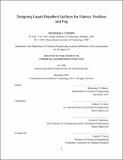Designing liquid repellent surfaces for fabrics, feathers and fog
Author(s)
Chhatre, Shreerang S. (Shreerang Sharad)
DownloadFull printable version (14.99Mb)
Other Contributors
Massachusetts Institute of Technology. Department of Chemical Engineering.
Advisor
Robert E. Cohen and Gareth H. McKinley.
Terms of use
Metadata
Show full item recordAbstract
Omniphobicity refers to a property of surfaces which are not wetted by water, oils, alcohols and other low surface tension liquids. Robust omniphobic surfaces can be applied in many areas including fabrics with chemical / biological protection and dirt / fingerprint resistant touch screens. The main aim of this thesis is to develop rules for the systematic design of omniphobic surfaces with a focus on textiles. First, a design chart is developed to help us understand the impact of surface chemistry and surface topography on the wettability of a textured surface. A smaller characteristic length scale of a re-entrant surface topography, tighter weave and a coating with inherently low wettability are better for producing omniphobic surfaces that resist wetting by liquids with low surface tension. This framework is applied to textile fabrics and bird feathers to test their wettability. Using this framework, wettability of low surface tension liquids on a polyester fabric is tuned or switched using either thermal annealing or biaxial stretching. Army Combat Uniform fabrics are rendered oleophobic, thus opening the way to optimize omniphobic army uniforms. The wettability of molecules similar to fluorodecyl POSS is investigated by measuring the contact angles with liquids of a broad range of surface tension and polarity. Of the molecules tested so far, fluorodecyl POSS has the lowest solid surface energy (9.3 mN/m) and the lowest increment in solid surface energy (7 mN/m). The wetting aspects of the hierarchical topography of bird feathers are captured using contact angle measurements in terms of a spacing ratio. Thermodynamics of the wetting of feathers and the robustness against wetting during the course of a dive are correlated to the wing spreading behavior. Our understanding of surface wettability of woven meshes is applied to optimize their fog collection ability. A business case for fog harvesting is developed and strategies to decrease asset and cash flow risks are proposed. The contributions presented here provide means to better characterize surfaces with complex topography, tune and a priori predict their wettability and recommend a design strategy both at a molecular and a macroscopic level to maximize their non-wettability.
Description
Thesis (Ph. D. in Chemical Engineering Practice)--Massachusetts Institute of Technology, Dept. of Chemical Engineering, February 2013. This electronic version was submitted by the student author. The certified thesis is available in the Institute Archives and Special Collections. Cataloged from student-submitted PDF version of thesis. "December 2012." Includes bibliographical references.
Date issued
2013Department
Massachusetts Institute of Technology. Department of Chemical EngineeringPublisher
Massachusetts Institute of Technology
Keywords
Chemical Engineering.